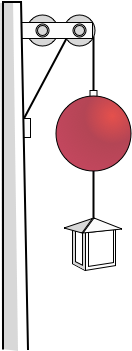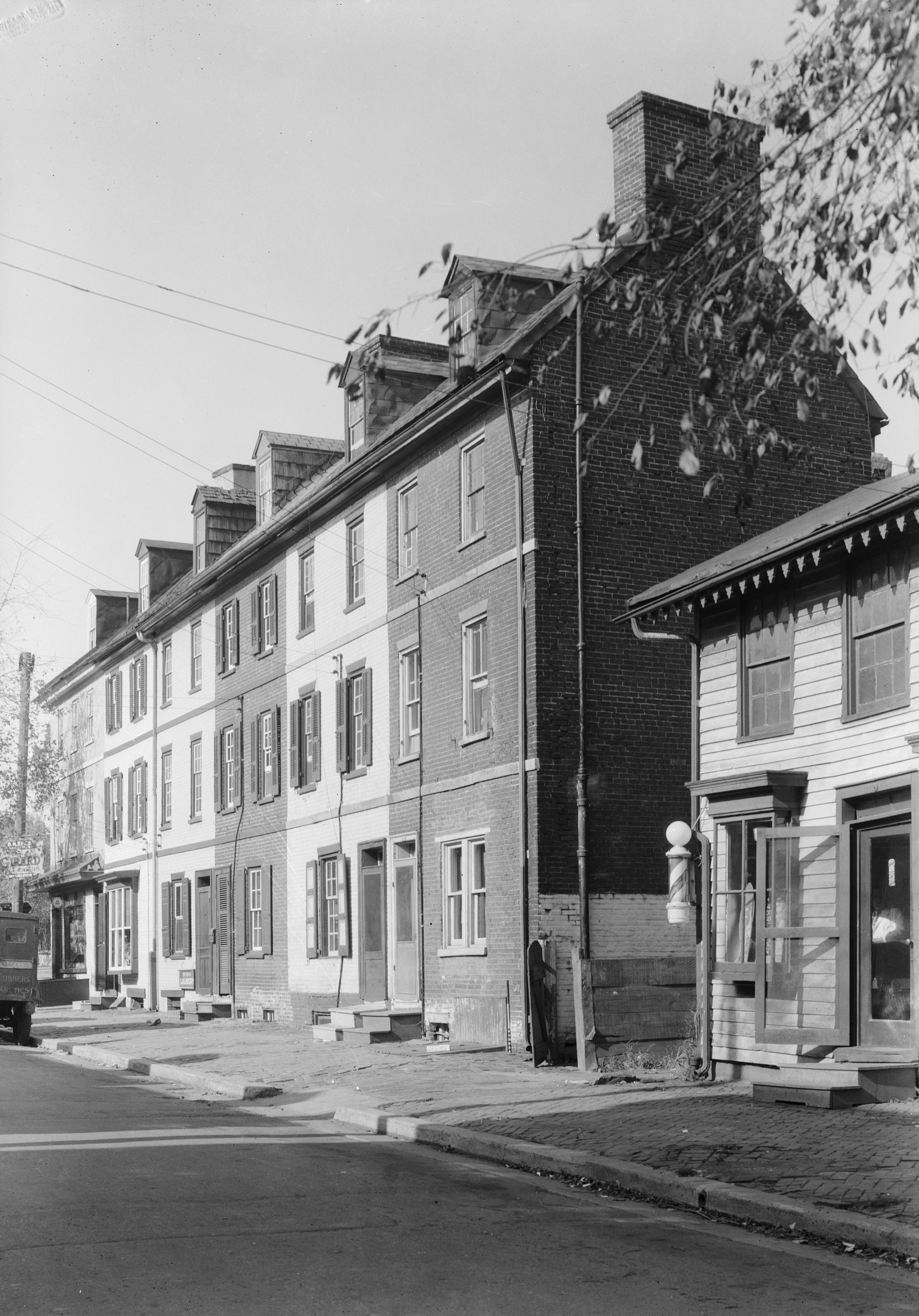|
Highball Signal
Highball Signal is a historic railroad signal located in Delmar, Delaware, United States. It is a white sphere mounted on a pole and located next to the railroad tracks to signal permission for a train to proceed at full speed, if the ball was at the top of the pole. The term "highball" came to be synonymous with a clear right-of-way and for trains to proceed at full speed. It was originally in service at New Castle, Delaware, and then at Hurlock, Maryland. The highball signal was moved to Delmar for display during the town's centennial in 1959, and is no longer used to direct railroad traffic, but is maintained as a public exhibition in a park near the railroad. and ' It was placed on the US National Register of Historic Places The National Register of Historic Places (NRHP) is the United States federal government's official list of districts, sites, buildings, structures and objects deemed worthy of preservation for their historical significance or "great artistic v ... in ... [...More Info...] [...Related Items...] OR: [Wikipedia] [Google] [Baidu] |
Delmarva Central Railroad
The Delmarva Central Railroad is an American short-line railroad owned by Carload Express that operates of track on the Delmarva Peninsula in the states of Delaware, Maryland, and Virginia. The railroad operates lines from Porter, Delaware to Hallwood, Virginia and from Harrington, Delaware to Frankford, Delaware along with several smaller branches. The DCR interchanges with the Norfolk Southern Railway and the Maryland and Delaware Railroad. The railroad was created in 2016 to take over the Norfolk Southern Railway lines on the Delmarva Peninsula. The DCR expanded by taking over part of the Bay Coast Railroad in 2018 and the Delaware Coast Line Railroad in 2019. Operations The DCR operates on of trackage on the Delmarva Peninsula in the states of Delaware, Maryland, and Virginia. The DCR's main line runs from Porter, Delaware south to Pocomoke City, Maryland on the Delmarva Subdivision, with the section leading into Pocomoke City called the Pocomoke Industrial Track. The main ... [...More Info...] [...Related Items...] OR: [Wikipedia] [Google] [Baidu] |
Delmar, Delaware
Delmar is a town in Sussex County, Delaware, United States, on the Maryland border along the Transpeninsular Line. Its motto is "The Little Town Too Big for One State." The population was 1,597 at the 2010 census, an increase of 13.5% over the previous decade. It is part of the Salisbury, Maryland-Delaware Metropolitan Statistical Area and a suburb of Salisbury, MD. When added with Delmar, Maryland, the total population of the town was 4,600 at the 2010 Census. History The Town of Delmar was founded in October 1859 with the extension of the Delaware Railroad to the southern boundary of Delaware. The Transpeninsular Line was responsible for the founding of this unique bi-state town because the Charter of the Delaware Railroad Company permitted only the building of a railroad within the State of Delaware and the charter of the corresponding railroad company in Maryland permitted only the laying of railroad track within the State of Maryland. Thus, in 1859, the two respectiv ... [...More Info...] [...Related Items...] OR: [Wikipedia] [Google] [Baidu] |
Railroad Signal
A railway signal is a visual display device that conveys instructions or provides warning of instructions regarding the driver’s authority to proceed. The driver interprets the signal's indication and acts accordingly. Typically, a signal might inform the driver of the speed at which the train may safely proceed or it may instruct the driver to stop. Application and positioning of signals Originally, signals displayed simple stop or proceed indications. As traffic density increased, this proved to be too limiting and refinements were added. One such refinement was the addition of distant signals on the approach to stop signals. The distant signal gave the driver warning that they were approaching a signal which might require a stop. This allowed for an overall increase in speed, since train drivers no longer had to drive at a speed within sighting distance of the stop signal. Under timetable and train order operation, the signals did not directly convey orders to the t ... [...More Info...] [...Related Items...] OR: [Wikipedia] [Google] [Baidu] |
Traffic
Traffic comprises pedestrians, vehicles, ridden or herded animals, trains, and other conveyances that use public ways (roads) for travel and transportation. Traffic laws govern and regulate traffic, while rules of the road include traffic laws and informal rules that may have developed over time to facilitate the orderly and timely flow of traffic. Organized traffic generally has well-established priorities, lanes, right-of-way, and traffic control at intersections. Traffic is formally organized in many jurisdictions, with marked lanes, junctions, intersections, interchanges, traffic signals, or signs. Traffic is often classified by type: heavy motor vehicle (e.g., car, truck), other vehicle (e.g., moped, bicycle), and pedestrian. Different classes may share speed limits and easement, or may be segregated. Some jurisdictions may have very detailed and complex rules of the road while others rely more on drivers' common sense and willingness to cooperate. Organization ... [...More Info...] [...Related Items...] OR: [Wikipedia] [Google] [Baidu] |
New Castle, Delaware
New Castle is a city in New Castle County, Delaware, United States. The city is located six miles (10 km) south of Wilmington and is situated on the Delaware River. As of the 2010 census, the city's population was 5,285. History New Castle was originally settled by the Dutch West India Company in 1651 under the leadership of Peter Stuyvesant on the site of a former aboriginal village, "Tomakonck" ("Place of the Beaver"), to assert their claim to the area based on a prior agreement with the aboriginal inhabitants of the area. The Dutch originally named the settlement Fort Casimir, but this was changed to Fort Trinity (Swedish: ''Trefaldighet'') following its seizure by the colony of New Sweden on Trinity Sunday, 1654. The Dutch conquered the entire colony of New Sweden the following year and rechristened the fort Nieuw-Amstel ("New Amstel", after the Amstel). This marked the end of the Swedish colony in Delaware as an official entity, but it remained a semi-autonomous unit ... [...More Info...] [...Related Items...] OR: [Wikipedia] [Google] [Baidu] |
Hurlock, Maryland
Hurlock is a town in Dorchester County, Maryland, United States. The population was 2,092 at the 2010 census. History The town was named after John M. Hurlock, a local store owner. The community was incorporated in 1892. Geography Hurlock is located at . According to the United States Census Bureau, the town has a total area of , of which is land and is water. Demographics 2010 census As of the census of 2010, there were 2,092 people, 788 households, and 536 families living in the town. The population density was . There were 903 housing units at an average density of . The racial makeup of the town was 55.0% White, 37.5% African American, 0.6% Native American, 0.8% Asian, 3.5% from other races, and 2.6% from two or more races. Hispanic or Latino of any race were 6.7% of the population. There were 788 households, of which 36.8% had children under the age of 18 living with them, 40.9% were married couples living together, 20.2% had a female householder with no husband pre ... [...More Info...] [...Related Items...] OR: [Wikipedia] [Google] [Baidu] |
National Register Of Historic Places
The National Register of Historic Places (NRHP) is the United States federal government's official list of districts, sites, buildings, structures and objects deemed worthy of preservation for their historical significance or "great artistic value". A property listed in the National Register, or located within a National Register Historic District, may qualify for tax incentives derived from the total value of expenses incurred in preserving the property. The passage of the National Historic Preservation Act (NHPA) in 1966 established the National Register and the process for adding properties to it. Of the more than one and a half million properties on the National Register, 95,000 are listed individually. The remainder are contributing resources within historic districts. For most of its history, the National Register has been administered by the National Park Service (NPS), an agency within the U.S. Department of the Interior. Its goals are to help property owners and inte ... [...More Info...] [...Related Items...] OR: [Wikipedia] [Google] [Baidu] |
Railway Buildings And Structures On The National Register Of Historic Places In Delaware
Rail transport (also known as train transport) is a means of transport that transfers passengers and goods on wheeled vehicles running on rails, which are incorporated in Track (rail transport), tracks. In contrast to road transport, where the vehicles run on a prepared flat surface, rail vehicles (rolling stock) are directionally guided by the tracks on which they run. Tracks usually consist of steel rails, installed on Railroad tie, sleepers (ties) set in track ballast, ballast, on which the rolling stock, usually fitted with metal wheels, moves. Other variations are also possible, such as "slab track", in which the rails are fastened to a concrete foundation resting on a prepared subsurface. Rolling stock in a rail transport system generally encounters lower friction, frictional resistance than rubber-tyred road vehicles, so passenger and freight cars (carriages and wagons) can be coupled into longer trains. The rail transport operations, operation is carried out by a ... [...More Info...] [...Related Items...] OR: [Wikipedia] [Google] [Baidu] |


.jpg)



